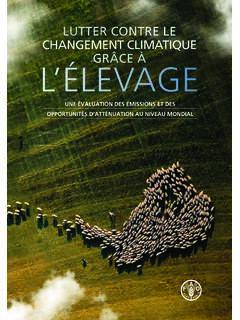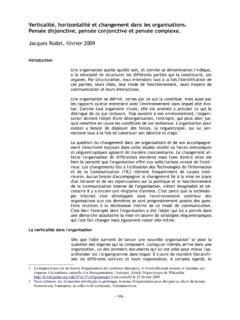Transcription of PlusICETM - PCM Products
1 Phase Change Material Products LimitedPlusICETMP hase Change MaterialsINNOVATION FOR ENERGY SAVING TECHNOLOGIESREDUCED RUNNING COSTLoad shifting provides reliable operation and lower annualelectricity / energy running MACHINERYS hifting some of the peak load may enable designers to reduce themain machine CAPACITYAs a retrofit application, the additional TES load may increase thesystem output with any additional SOLUTIONR educed machinery size, energy consumption results in both directand indirect CO2 RESPONSEC ustom-made containers offer quicker response in comparison withany other TES systems on the MAINTENANCE COSTM achinery runs for longer periods without any start / stop andtherefore it offers a far more reliable SYSTEMThe overall machinery capacity and TES capacity can be exactlymatched to system CAPACITYIn case the main machinery fails, the stored energy can be utilised tohandle the system loads, hence, providing a degree of back up ENERGY STORAGE;Thermal Energy Storage (TES) is the temporary storage of high or lowtemperature energy for later use.
2 It bridges the gap between energyrequirement and energy use. A thermal storage application may involve a 24hour or alternatively a weekly or seasonal storage cycle depending on thesystem design requirements. Whilst the output is always thermal, the inputenergy may be either thermal or Change Materials (PCMs) are Products that store and release thermalenergy during the process of melting & freezing (changing from one phase toanother). When such a material freezes, it releases large amounts of energyin the form of latent heat of fusion, or energy of crystallisation. Conversely,when the material is melted, an equal amount of energy is absorbed from theimmediate environment as it changes from solid to the majority of the applications, PCM solutions have to be encapsulated in sealed containers.
3 To this end, PCM Products Ltd. havedeveloped many different standard type containers as well as custom-made containers for special applications. These containers canbe applied to any water or air based TES systems and can be manufactured using our PlusICE Phase Change Materials (PCM) solutionswhich have operating temperatures between-40 C (-40 F)and+117 C (+243 F).BENEFITST ypical APPLICATIONSPRODUCTS;1) FlatICE Containers:These containers are constructed of blow moulded HDPE and can be filled with positive or negativetemperature PCMs, although high temperature PCMs may be unsuitable due to softening of theplastic. When stacked there is a small gap between each container, allowing either air or water to floweasily over the containers while providing a large PCM surface area for heat )TubeICE:The PCM-filled HDPE tubular design enables them to be stacked effectively in both rectangular andcylindrical tanks with minimal void ) BallICE:This technology is only available for use with our positive temperature organic range of PCMs, andinvolves the PCM being directly incorporated into a plastic or rubber matrix.
4 This is then moulded toproduce standard sized custom-made HDPE plastic containers are filledwith PlusICE PCM solutions and the filling port fullywelded after filling in order to ensure safe andreliable design of the container incorporatesinternal support columns as well as externalguide circles so that the containers canbe stacked on top of each other forming aself-assembling large heat exchanger within the self-stacking concept can beapplied for both water and air circuitsand the gap between each containerprovides an ideal flow passage with alarge heat exchange ALTERNATIVE TO REDUCE ENERGYFlatICETMFEATURES;FlatICETMTANK DESIGN;Generally concrete tanks are either built buried below ground level and the top of thetank used as parking or landscape areas or alternatively within the basement area aspart of the ideally should be constructed as close as possible to the chiller and load tominimise the pipework and pumping energy penalties.
5 If the system requiresa pressurised tank a cylindrical tank can be constructed to accommodate FlatICEcontainers with minimum containers can only be stacked up to aheight of m (8 ft) and therefore the heightof the tank is restricted to around 3m (10 ft) andthe foot print of the tank can be adjusted aroundthis principle, the longer the tank the larger the temperature differenceone can achieve across the tank and the width / length ratios can beadjusted to suit the site , if the required storage capacity is too large and thedesign requires multiple tanks, they can be arranged either inparallel or series format to suit the application and available the depth of the tank will be m (8 ft) insidedimension which corresponds to approx.
6 65 FlatICE containers highand 150mm (6 ) of head room above the containers. Therefore, toestimate the approximate rectangular tank size and shape one canuse the following formula inline with FlatICE capacity Units;Load (kWh)----------------------------------- ----- = Tank Volume (m3)FlatICE Capacity (kWh / m3)No of FlatICE = 200 x Tank Volume (m3)Using the ideal aspect ratios of between 1:4~1:6, tanklength can be Units;Load (Ton-hr)-------------------------------- ------ = Tank Volume (USG)FlatICE Capacity (Ton-hr / USG)No of FlatICE = x Tank Volume (USG)Using the ideal aspect ratios of between 1:4~1:6, tanklength can be 20 11 2 PCM Products has a policy of continuous product and product data improvement and reserves the right to change design and specification without notice NATURAL ALTERNATIVE TO REDUCE ENERGYSI Units;Load (kWh)----------------------------------- -------- = Tank Volume (m3)TubeICE Capacity (kWh / m3)No of TubeICE = 440 x Tank Volume (m3)Using the ideal aspect ratios of between 1:4~1:6, tanklength can be Units.
7 Load (Ton-hr)-------------------------------- -------------- = Tank Volume (USG)TubeICE Capacity (Ton-hr / USG)No of TubeICE = x Tank Volume (USG)Using the ideal aspect ratios of between 1:4~1:6, tank lengthcan be ;TubeICE concept is based on custom-made plastic containers filled with our PlusICEP hase Change Materials (PCM) solutions which have operating temperatures between-40 C (-40 F)and+117 C (+243 F). They can be stacked in either cylindrical /rectangular tanks for atmospheric / pressurized systems for a variety of thermalenergy storage custom-made HDPE plasticcontainers are filled with PlusICE PCMsolutions and the filling port fully sealedafter filling for safe and reliable self-stacking concept can be appliedfor both water and air circuits and the gapbetween each container provides an idealflow passage with a large heat exchange surface with minimal pressure ChangeTemperature(C)Phase ChangeTemperature(F)Weightkg/TubeICEW eightLb/TubeICETubeICE(kWh/TubeICE)TES TankCapacity(kWh/m3)TubeICE(Ton-hr/TubeI CE)TES TankCapacity(Ton-hr/USG) Design.
8 TubeICE TES tanks can be any shape or form to suit site requirements. Tank volumes are calculated based on the required TEScapacity and later designed to suit the site layout and restrictions. Tanks can be either atmospheric or pressurised up to 10 Barg(145 Psig). Tanks can be constructed using plastic, steel or concrete and they can be installed in either under- or above groundapplications. TubeICE containers can be placed inside the tank using the manhole provided and stacked to form a heat exchangesurface between the diffuser can be supplied with supply and return headers providing ideal flow conditions within the tank to suit the temperature range andPCM type.
9 This not only provides ideal heat transfer co-efficiency but also theweight and operational PCM balance can be modified to provide ideal thermalstratification conditions for the tank as a whole. Standard range of bothcylindrical and rectangular sectional tanks are available to suit any chilledwater, heat recovery, heating andsolar heat recovery standard cylindrical tankscan be manufactured indiameter to height aspect ratiosof up to 1:5. The steel tanks areshipped plain and are generallyinsulated on site but plastic tanks can be supplied in 55 mm (2 ) pre-insulated form sectional and fully internally flanged rectangular tanks are supplied in and1mx1m ( and ) complete with 55mm (2 ) thick insulated sectionsand they are built on site to suit the site layout.
10 PCM Products has a policy of continuous product and product data improvement and reserves the right to change design and specification without notice Full Storage Charging ModeFull Storage Discharging ModePartial Storage Charging ModePartial Storage Discharging ModeINNOVATION FOR ENERGY SAVING TECHNOLOGIESTYPICAL TANK OPERATION;FlatICETM& TubeICETMTANK APPLICATION;Generally concrete tanks are either built below ground buried and the top of the tank usedas a parking or landscape areas or alternatively within the basement area as part of thefoundations. However, if this can not be achieved or as aRetrofit application, sectional tanks can be manufacturedand installed on site either within the basement or roof , the pressurised tanks can be built toaccommodate the containers and buried outside orwithin the building area.










